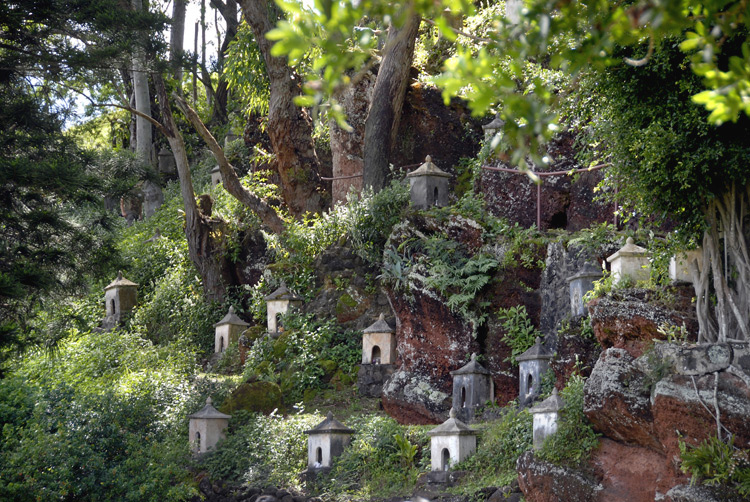88 Shrines

This morning we took a short trek up to Lawai to visit the International Peace Center's openhouse. It was so clear and bright that all the heavy cloud leis were gone from the mountains, and we could see their green rumpled skirts all around us. It's easy to forget to see them-- everything was bright today.
The center is back in a little residential neighborhood. A flock of pretty goats graze the grass out front, and a cheerful greeter in a straw hat and designer sandals showed us to some lawn chairs with a serene view and gave us some jasmine tea and Manju--Japanese pastries. We joked under our breath that the red dot on top was the mind altering drugs. Our greeter said to sit and enjoy the peaceful surroundings for a moment while the previous tour finished up the orientation.
The view from our lawnchairs was lovely--a long grassy mound in front of an imposing rock wall. Matt wondered, "oh no, the site of a heiau?" Sure enough, yes. A particularly powerful one, in the shape of an enormous turtle. Above the heiau wall there is a grassy bench and a winding path up a bare-rock cliff. Orchids and banyan trees with draped white roots descend the face, which is dabbed with small cement shrines. We drank our tea, watching the jasmine leaves unfurl in the cup, said hello to the goats, and walked around the shady lawn. After a little while we were shown into a little tent and shown this video about the history of the place.
Lawai valley has always been a pilgrimage site for Hawaiians-- the stream is said to have healing properties. And when the Japanese immigrants came in, they built these 88 small shrines on the site of the heiau, each representing 100 shrines in Shikoku, Japan. The camp was right there where we sipped our tea, with three buddhist temples, a sumo arena and an O-Bon dance ground. The place fell into disrepair over the years-- WW2 encouraged Japanese immigrants to integrate into the greater cultural context, and disassociate themselves from suspicious Japanese insularity. In the 60s, the Lawai cannery closed and the last few people moved away from the site. The landowner tried to sell the place for condos.
But skip a bit, and now it's been restored, bought with the proceeds of thousands of malasadas and 100s of jars of pickled mango sold at the county fair. Plus a couple of enormous private donations.
Once we've been oriented, and are sufficiently impressed with the cultural and spiritual importance of the place, our greeter takes us to the entrance: a low and narrow cave ribbed with banyan roots like living bones. We duck down and squeeze through and greet the first shrine semi prostrate in the dim womblike cave: two red kanji are painted on the side: ichi-ban. Then we come out into the light and we're on a narrow path that zigzags across the face of the cliff. We stop at each of the shrines and my two year old shouts, "look, there's a BUDDHA!" The little statues are all handmade by plantation workers-- some are eroded, some are carved of wood and painted, some are in shallow relief with such simple features they look like Tikis. Some of the Buddhas are sitting on lotuses, a few are baby Buddhas, standing up and pointing at earth and heaven. We even saw a pair of grumpy Buddhas-- cartoony downward frowns on their faces, and a sword in one hand, a blunt club in the other. Those, she announces, are her favorite.
Many of the shrines appeared empty. The empty platforms where the Buddhas once sat now held small offerings-- stones, a flower, a few beads. When Rosie asked, "Where's the Buddha?" Matt said, "All of the little houses have Buddhas inside. He just looks different. That's just like us!"
It was a beautiful place. From the top of the cliff we could see out over Lawai valley, in the clear air we could see the mountains and the valleys, the houses. The shrines were so moving-- those good natured little Buddhas in there, and the generations of care and faith that had created and maintained them.
Comments
Post a Comment